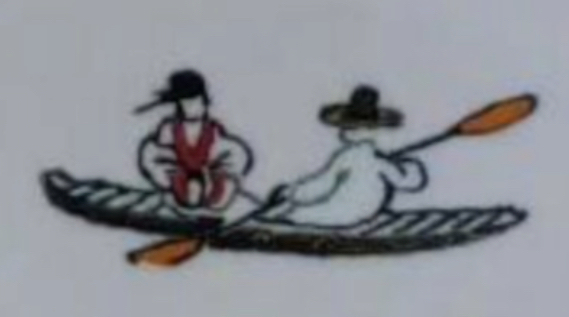Intersecting with Eternity
與魏晉兄弟
游唐宋河山
Lao Shu 老樹 is the nom de plume of Liu Shuyong (劉樹勇, 1962-), a Beijing-based artist, writer, critic and professor in communications. His artistic voice is unique and personal, its tenor, whimsy and profundity evoke what for decades we have called The Other China — a cultural noosphere that is as undeniably local as it is universal.
As Lao Shu notes in a few sparse lines inscribed on a porcelain vase on a rain-drenched summer’s day in the 2024 Year of the Dragon (see below), his art evokes a world that draws inspiration from his mind-travels in the landscapes of the Tang and Song eras (early seventh to the early twelfth centuries CE). During his ventures he enjoys a fellowship with the eccentrics and prickly individuals of the Wei-Jin period (third century to the mid sixth century CE), one known for moments of splendour amidst waves of murderous political disorder.
For some readers, Lao Shu’s inscription may recall Charles Lamb’s famous observations about the speciosa miracula of old china, where ‘old friends—whom distance cannot diminish—figuring up in the air (so they appear to our optics), yet on terra firma still … .’
***
For details of the Wei-Jin era in the series The Tower of Reading, see the chapters from New Tales of the World 世說新語:
As well as the work of Tao Yuanming (陶淵明, 365-427 CE), the famed recluse-poet who rejected service to the state to pursue a life of leisure, writing, drinking, and occasional agricultural pursuits. As we noted in Substance, Shadow, Spirit 形影神, Tao’s quest for quietude, one tinged with worldly concerns, indulgences and fears, is recorded in poems that, for over 1600 years, have inspired artists and writers alike.
Lao Shu’s work continues in that ancient lineage and it offers what Feng Zikai 豐子愷 called ‘a temporary escape from the dusty world’ 暫時脫離塵世. (For more on this topic, see On Heritage, an essay about the rationale behind China Heritage.)
***
Intersecting with Eternity is a mini-anthology of literary and artistic works, past and present, that are part of the unbroken stream of human awareness and poetic self-reflection. It is a companion to The Tower of Reading and an extension of The Other China, two other featured topics in China Heritage.
— Geremie R. Barmé
Editor, China Heritage
13 July 2024
***
Lao Shu in China Heritage:
- The Whimsy and Wisdom of Lao Shu, in a summer of discontent, 12 August 2022
- Lao Shu’s Fall, 12 December 2023
- Lao Shu’s New Year, 4 January 2024
- Lao Shu’s Farewell to the Year of the Rabbit, 31 January 2024
- ‘Do you really think you can eat those pies in the sky?’, 29 February 2024
- Lao Shu — an artist in all seasons, 30 June 2024
A Four-sided Realm
Travelling through Tang-Song landscapes
in the company of my Wei-Jin brothers
My eyes feast on boundless green delights
moving amidst the vicissitudes of the ages
— Lao Shu, inscribed on a four-sided porcelain
vase in heavy rain, mid-summer, in the
Jiachen Year of the Dragon (2024)

***

***

***

Three Vignettes

It’s treacherous out there,
and I’ve long seen through it all.
Let me keep it at arm’s length
and stay put by these lotus flowers.
— Lao Shu, letting the brush take its course,
summer of the Jiachen Year of the Dragon
***

晨起露未乾,
荷鋤下農田。
鮮花一大片,
開在小路邊。
Up before the dew had even dried away
Shouldering a hoe to work in the fields
There was this field of brilliant flowers
Blossoming along the roadside
***

Flowers touch me and I’m moved by flowing water.
Without such uplift, how could I possibly cope?
— Lao Shu, letting the brush take its course,
summer of the Jiachen Year of the Dragon
***
Source:
- 老樹畫畫,微博,2024年7月2至9日
***


